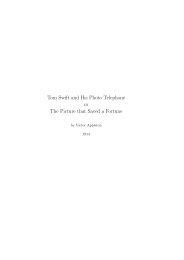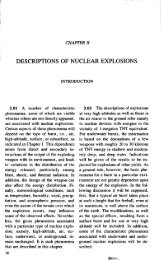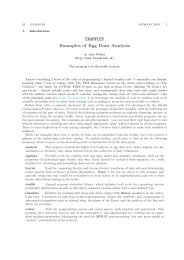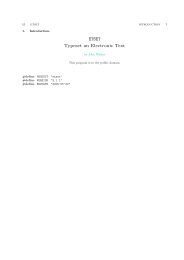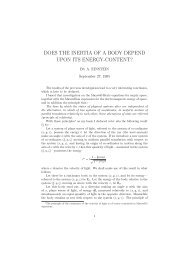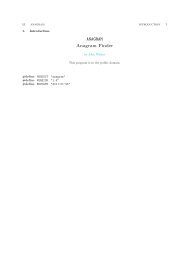The Annoyance Filter.pdf - Fourmilab
The Annoyance Filter.pdf - Fourmilab
The Annoyance Filter.pdf - Fourmilab
You also want an ePaper? Increase the reach of your titles
YUMPU automatically turns print PDFs into web optimized ePapers that Google loves.
§250 ANNOYANCE-FILTER ISO 8859-1 CHARACTER TYPES 201<br />
250. ISO 8859-1 character types.<br />
<strong>The</strong> following definitions provide equivalents for ctype.h macros which work for ISO-8859 8 bit<br />
characters. <strong>The</strong>y require that ctype.h be included before they’re used.<br />
〈 Global variables 226 〉 +≡<br />
#define ISOch (x) (static cast〈unsigned char〉((x) & # FF))<br />
#define isISOspace (x) (isascii (ISOch (x)) ∧ isspace (ISOch (x)))<br />
#define isISOalpha (x) ((isoalpha [ISOch (x)/8] & ( # 80 ≫ (ISOch (x) % 8))) ≠ 0)<br />
#define isISOupper (x) ((isoupper [ISOch (x)/8] & ( # 80 ≫ (ISOch (x) % 8))) ≠ 0)<br />
#define isISOlower (x) ((isolower [ISOch (x)/8] & ( # 80 ≫ (ISOch (x) % 8))) ≠ 0)<br />
#define toISOupper (x) (isISOlower (x) ? (isascii (((unsigned<br />
char)(x))) ? toupper (x) : (((ISOch (x) ≠ # DF)∧(ISOch (x) ≠ # FF)) ? (ISOch (x)− # 20) : (x))) : (x))<br />
#define toISOlower (x) (isISOupper (x) ? (isascii (ISOch (x)) ? tolower (x) : (ISOch (x) + # 20)) : (x))<br />
251. <strong>The</strong> following tables are bit vectors which define membership in the character classes tested for<br />
by the preceding macros.<br />
〈 Global variables 226 〉 +≡<br />
const unsigned char isoalpha [32] = {0, 0, 0, 0, 0, 0, 0, 0, 127, 255, 255, 224, 127, 255, 255, 224, 0, 0, 0, 0,<br />
0, 0, 0, 0, 255, 255, 254, 255, 255, 255, 254, 255};<br />
const unsigned char isoupper [32] = {0, 0, 0, 0, 0, 0, 0, 0, 127, 255, 255, 224, 0, 0, 0, 0, 0, 0, 0, 0, 0, 0, 0, 0,<br />
255, 255, 254, 254, 0, 0, 0, 0};<br />
const unsigned char isolower [32] = {0, 0, 0, 0, 0, 0, 0, 0, 0, 0, 0, 0, 127, 255, 255, 224, 0, 0, 0, 0, 0, 0, 0, 0,<br />
0, 0, 0, 1, 255, 255, 254, 255};<br />
252. To perform component tests during the development process we provide a test jig in which<br />
the component may be figuratively mounted and exercised. When compiled with Jig defined, a −−jig<br />
option (without argument) is included to activate the test.<br />
〈 Test component in temporary jig 252 〉 ≡<br />
#ifdef Jig<br />
#endif<br />
This code is used in section 243.<br />
253. <strong>The</strong> component in the temporary test jig may require some items declared in global context.<br />
Here’s where you can put such declarations.<br />
〈 Global declarations used by component in temporary jig 253 〉 ≡<br />
#ifdef Jig<br />
#endif<br />
This code is used in section 223.




